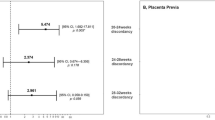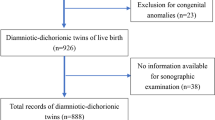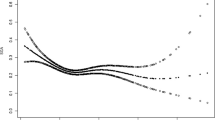Abstract
Objective:
To establish the optimal threshold of birth weight discordance (BWD) for prediction of stillbirth, perinatal mortality and morbidity in twins born in British Columbia with or without chorionicity information.
Study Design:
This is a retrospective population-based cohort study of twins born in British Columbia from 2000 to 2010. Data from one hospital was used to adjust for chorionicity. Multivariate generalized estimating equation and receiver operating characteristic curve analyses were performed to evaluate the predictability of BWD in comparison with other fetal anthropometric measurements. Positive likelihood ratio is used to estimate test accuracy. Survival analysis was conducted to take gestational age and other confounders into account.
Results:
We analyzed two cohorts, with (pairs=1493) and without (pairs=6328) chorionicity information, of which 1.5% experienced stillbirth, 2.9% suffered perinatal mortality and 22.6% identified with perinatal morbidities. BWD was a significant predictor of stillbirth. Standard receiver operating characteristic curve analysis and survival analysis suggested that BWD of ⩾30% is the optimal thresholds for stillbirth and perinatal mortality irrespective of chorionicity. However, the P-value for predictive accuracy of BWD was nonsignificant for perinatal morbidity, after adjusting for confounding variables engaging multivariate analysis. Sex discordance can be used as a proxy for chorionicity.
Conclusion:
BWD is a good predictor for stillbirth. A BWD cutoff limit of 30% and higher has optimal accuracy for detecting perinatal mortality.
This is a preview of subscription content, access via your institution
Access options
Subscribe to this journal
Receive 12 print issues and online access
$259.00 per year
only $21.58 per issue
Buy this article
- Purchase on Springer Link
- Instant access to full article PDF
Prices may be subject to local taxes which are calculated during checkout





Similar content being viewed by others
References
Soucie JE, Yang Q, Wen SW, Fung Kee Fung K, Walker M . Neonatal mortality and morbidity rates in term twins with advancing gestational age. Am J Obstet Gynecol 2006; 195 (1): 172–177.
Kucera H, Reinold E, Schonswetter P . Perinatal mortality in twin pregnancies. Progress in perinatology. Fortschr Med 1979; 97 (44): 2026–2031.
Charlemaine C, Duyme M, Ville Y, Aurengo A, Tremblay R, Frydman R et al. Fetal biometric parameters, twin type and birth weight difference. A longitudinal study. Eur J Obstet Gynecol Reprod Biol 2000; 93 (1): 27–32.
Chang Y-LY, Chang TT-C, Chang SD, Cheng PJ, Chao AS, Hsieh PC et al. Sonographic prediction of significant intertwin birth weight discordance. Eur J Obstet Gynecol Reprod Biol 2006; 127 (1): 35–40.
Packham K . Multiple pregnancy: the management of twin and triplet pregnancies in the antenatal period. Multiple pregnancy: the management of twin and triplet pregnancies in the antenatal period. 2011, pp 1–230 (last accessed 11 October 2015). Available at www.rcog.org.uk.
Vergani P, Locatelli A, Ratti M, Scian A, Pozzi E, Pezzullo JC et al. Preterm twins: what threshold of birth weight discordance heralds major adverse neonatal outcome? Am J Obstet Gynecol 2004; 191 (4): 1441–1445.
Diaz-Garcia C, Bernard JP, Ville Y, Salomon LJ, Jacobs AR, Demissie K . Validity of sonographic prediction of fetal weight and weight discordance in twin pregnancies. Prenat Diagn 2010; 30 (4): 361–367.
Jacobs AR, Demissie K, Jain NJ, Kinzler WL, AR J, D K et al. Birth weight discordance and adverse fetal and neonatal outcomes among triplets in the United States. Obstet Gynecol 2003; 101 (5, Part 1): 909–914.
Breathnach FFM, Malone FFDF . Fetal growth disorders in twin gestations. Semin Perinatol 2012; 36 (3): 175–181.
Wen SWSW, Tan H, Walker M . The association between intratwin birthweight discordance and preterm birth in twin pregnancy. Aust NZ J Obstet Gynaecol [Internet] 2006; 46 (5): 402–406.
Redman ME, Blackwell SC, Refuerzo JS, Kruger M, Naccasha N, Hassan SS et al. The ninety-fifth percentile for growth discordance predicts complications of twin pregnancy. Am J Obstet Gynecol 2002; 187 (3): 667–671.
Erkkola R, Ala-Mello S, Piiroinen O . Growth discordancy in twin pregnancies: a risk factor not detected by measurements of biparietal diameter. Am Coll Obstet Gynecol 1985; 66 (2): 203–206.
Kalish RB, Branum A, Sharma G, Keith LG, Blickstein I . Gestational age-specific distribution of twin birth weight discordance. J Perinat Med 2005; 33 (2): 117–120.
Perinatal Services British Columbia (2012): PSBC. POPDATABC (2015). Data Extract. PSBC (2014)..
Whiting P, Harbord R, de Salis I, Egger M, Sterne J . Evidence-based diagnosis [Internet]. J Heal Serv Res Policy 2008; 13 (Suppl 3): 57–63.
Parikh R, Parikh S, Arun E, Thomas R . Likelihood ratios: clinical application in day-to-day practice. Indian J Ophthalmol 2015; 57 (3): 217–221.
Breathnach F, McAuliffe F, Manning F, Carroll S, Malone F, Geary M et al. New thresholds for significant intratwin growth discordance: results of the prospective multicenter ESPRiT study. Am J Obstet Gynecol 2011; 204 (1): S18.
Joseph KS, Marcoux S, Ohlsson A, Kramer MS, Allen AC, Liu S et al. Preterm birth, stillbirth and infant mortality among triplet births in Canada, 1985-96. Paediatr Perinat Epidemiol 2002; 16 (2): 141–148.
Mahony R, Mulcahy C, McAuliffe F, Herlihy CO, Carroll S, Foley ME . Fetal death in twins. Acta Obstet Gynecol Scand 2011; 90 (11):1274–1280.
Kent EM, Breathnach FM, Gillan JE, McAuliffe FM, Geary MP, Daly S et al. Placental pathology, birthweight discordance, and growth restriction in twin pregnancy: results of the ESPRiT Study. Am J Obstet Gynecol 2012; 207 (3): 220–225.
Hartley RS, Hitti J, Emanuel I, Hartley RS, Hitti J, Emanuel I . Size-discordant twin pairs have higher perinatal mortality rates than nondiscordant pairs. Am J Obstet Gynecol 2002; 187 (5): 1173–1178.
Hollier LM, McIntire DD, Leveno KJ . Outcome of twin pregnancies according to intrapair birth weight differences. Obstet Gynecol 1999; 94 (6): 1006–1010.
Barrett J, Bocking A . Management of twin pregnancies (Part 11). J SOGC 2000; (92):6–9.
Beam CA . Analysis of clustered data in receiver operating characteristic studies. Stat Methods Med Res 1998; 7 (4): 324–336.
D’Antonio F, Khalil A, Dias T, Thilaganathan B . Weight discordance and perinatal mortality in twins: analysis of the Southwest Thames Obstetric Research Collaborative (STORK) multiple pregnancy cohort. Ultrasound Obstet Gynecol 2013; 41 (6): 643–648.
Sebire N, D’ercole C, Soares W . Intertwin disparity in fetal size in monochorionic and dichorionic pregnancies. Obstet 1998; 91: 82–85.
Hollier LM, McIntire DD, Leveno KJ . Outcome of twin pregnancies according to intrapair birth weight differences. Obstet Gynecol 1999; 94 (6):1006–1010.
Wen SW, Tan H, Yang Q, Walker M . Prediction of intra-twin birth weight discordance by binary logistic regression analysis. Gynecol Obstet Invest 2006; 62 (4): 186–192.
Puccio G, Giuffré M, Piccione M, Piro E, Rinaudo G, Corsello G . Intrauterine growth restriction and congenital malformations: a retrospective epidemiological study. Ital J Pediatr 2013; 39 (1): 23.
Vergani P, Locatelli L, Ratti M, Scian A, Zangheri G, Pezzullo JC et al. Predictors of adverse perinatal outcome in twins delivered at <37 weeks. J Matern Fetal Neonatal Med 2004; 16 (6): 343–347.
Morin L, Lim K . Ultrasound in twin pregnancies. J Obstet Gynaecol Can 2011; 33 (6): 643–656.
Cheung VYTY, Bocking AD, Dasilva OP . Preterm discordant twins: What birth weight difference is significant? Am J Obstet Gynecol 1995; 172 (3): 955–959.
Vergani P, Roncaglia N, Ghidini A, Crippa I, Cameroni I, Orsenigo F et al. Can adverse neonatal outcome be predicted in late preterm or term fetal growth restriction? Ultrasound Obstet Gynecol 2010; 36 (2): 166–170.
Pelizzoni F, Cozzolino S, Incerti M, Russo F, Verderio M, Vergani P . Perinatal and pregnancy outcome in dichorionic twins complicated by one twin with a fetal anomaly. Prenat Diagn 2012; 32: 115–116.
Talbot GT, Goldstein RF, Nesbitt T, Johnson JL, Kay HH . Is size discordancy an indication for delivery of preterm twins? Am J Obstet Gynecol 1997; 177 (5): 1050–1054.
Cooperstock MS, Bakewell J, Herman A, Schramm WF . Effects of fetal sex and race on risk of very preterm birth in twins. Am J Obstet Gynecol 1998; 179 (3, Part 1): 762–765.
Acknowledgements
We thank Dr Eugenia Oviedo-Joekes, Dr Patricia Spittal and Dr Martin Schechter, the members of thesis research committee, for the PhD program. This study was supported by a grant from the Canadian Institutes of Health Research (MAH-115445). We thank Dr. K.S. Joseph for providing such opportunity.
Disclaimer
All inferences, opinions and conclusions drawn in this publication are those of the authors and do not reflect the opinions or policies of the Data Steward(s).
Author information
Authors and Affiliations
Corresponding author
Ethics declarations
Competing interests
The authors declare no conflict of interest.
Rights and permissions
About this article
Cite this article
Jahanfar, S., Lim, K. & Oviedo-Joekes, E. Optimal threshold for birth weight discordance: Does knowledge of chorionicity matter?. J Perinatol 36, 704–712 (2016). https://doi.org/10.1038/jp.2016.82
Received:
Revised:
Accepted:
Published:
Issue Date:
DOI: https://doi.org/10.1038/jp.2016.82
This article is cited by
-
Assessment of different thresholds of birthweight discordance for early neonatal outcomes: retrospective analysis of 2348 twin pregnancies
BMC Pregnancy and Childbirth (2022)
-
Birth weight discordance in very low birth weight twins: mortality, morbidity, and neurodevelopment
Journal of Perinatology (2019)



